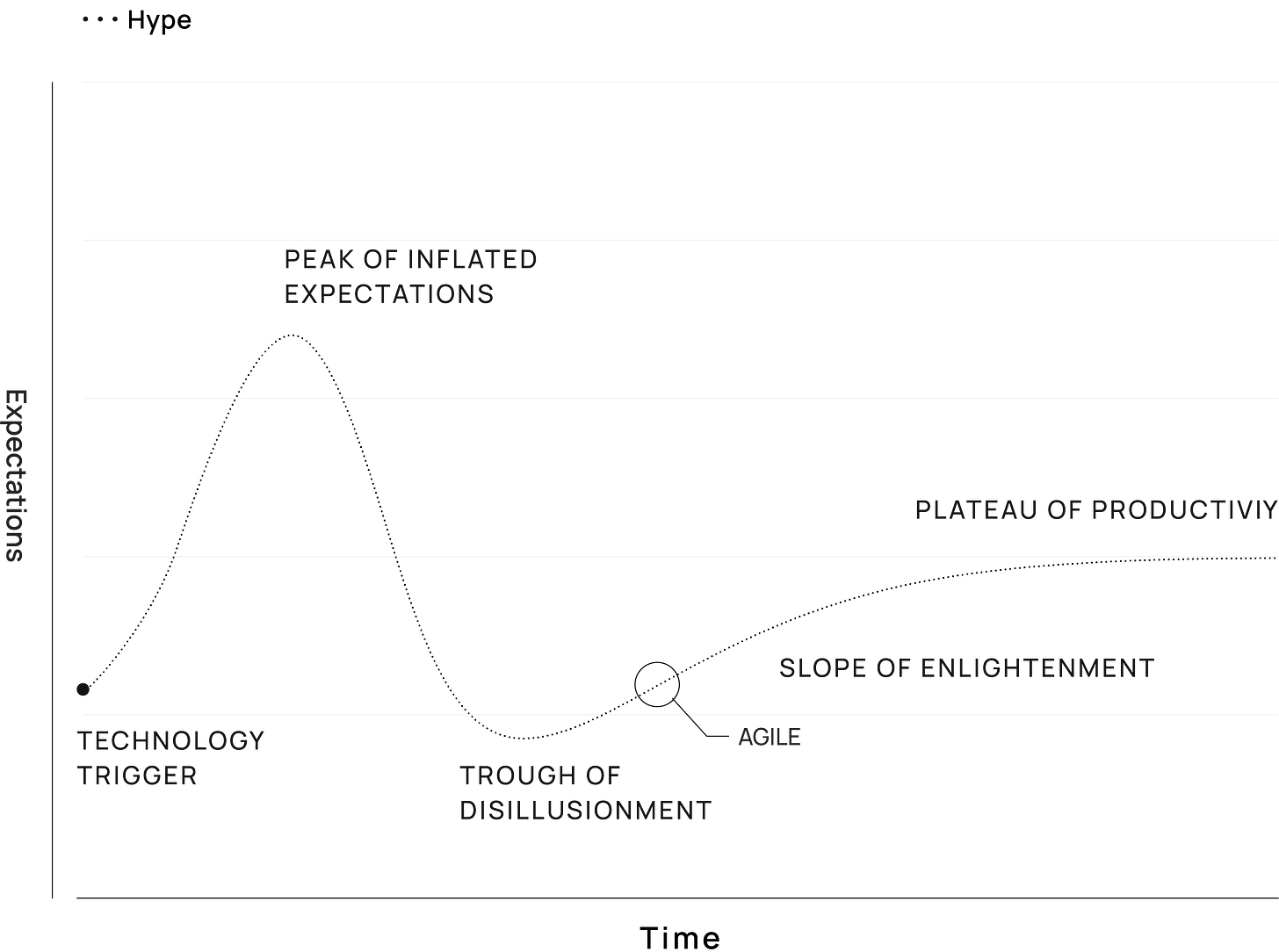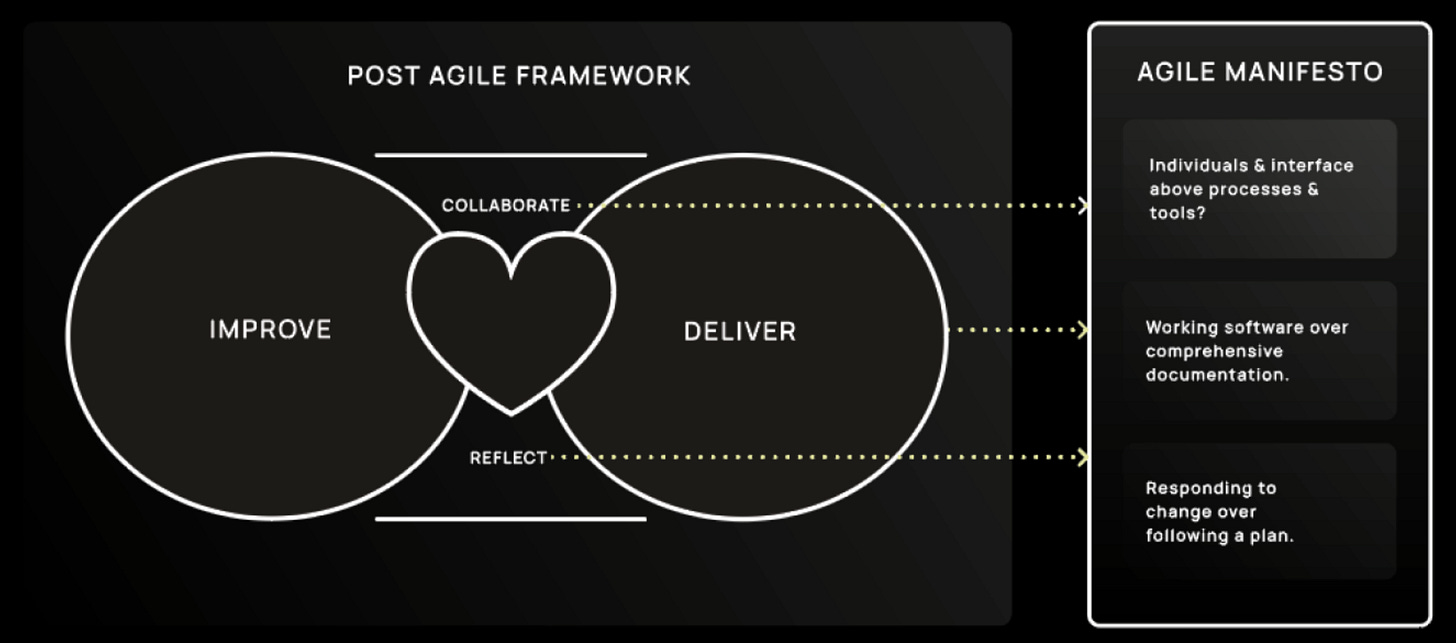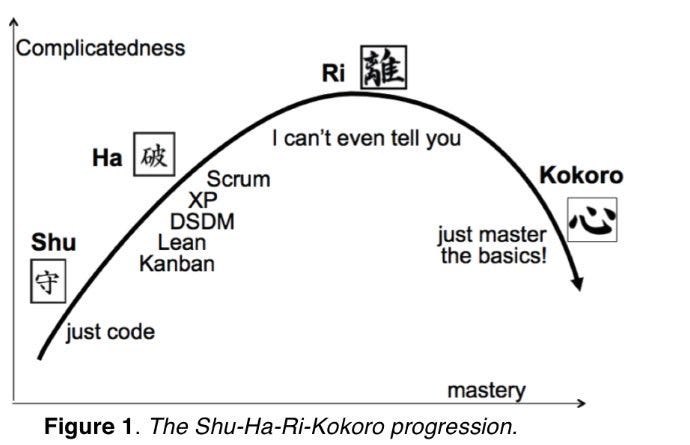Agile is dead, long live agile!
The post-agile era

This article first got published in the annual Shift 2023 report by In The Pocket, a European Digital Product Studio based in Ghent, Belgium. It was written by Thijs Morlion and Robert Stöhr.
On a snowy day out in the Rocky Mountains, in February 2001, 17 software delivery thought leaders came together. They searched for an alternative to the “waterfall” method: a documentation-driven, heavyweight software development process. The end result is known as the Agile Software Development Manifesto. Now, after more than 20 years, some have lost faith and proclaimed the death of agile. But is that really the case? Are we in the midst of a shift towards a post-agile era?
“The wrap”
Agile
”The gift”
The 4 principles of Agile
Since that particular day in February 2001, the principles and values of the Agile Manifesto have become increasingly established in software development. The Agile Manifesto quickly found its way to small and large organisations. Management bought into Agile techniques, and a whole generation of software developers grew up with the Agile principles fixed in their brains.
However, today some argue that the movement failed to deliver on all its promises. Tons of software projects follow agile ways, especially large-scale ones. And yet still fail horribly. They exceed the budget, often delivering products users don’t need or worse, detest. A smirk on the reputation of self-proclaimed agile companies. So where did it go wrong?
The Agile Manifesto is not as it was 20 years ago. Well, the Manifesto is the same. But the business behind it is not. The agile industrial complex is real. Agile certification has become Big Business. Brand-driven ecosystems, such as SAFe, Scrum, .. have stolen the spotlight and shifted focus on processes, tools and certification.
That’s exactly why people started doubting the intentions of agility. They’ve associated agility with bad experiences because of incorrectly implemented principles. It gave enough cause for some influential people to shout: agile is dead!
Through the hype cycle, into the post-agile era?
So is agile truly dead? Believers of this theory argue that agile has moved on the hype cycle via the trough of disillusionment towards a post-agile era. New post-agile frameworks, like ‘modern agile’ or ‘heart of agile’ gained popularity. But closer examination reveals that there’s not much difference between what these frameworks advocate for and what is essentially written in the original Agile Manifesto. This drive to distinguish ‘post-agility’ from ‘original agility’ arises from a couple of misconceptions that are widespread in our industry.
To begin with, agility is often seen as the fix-it-all holy grail. People think it will solve all of the problems within their organisation. And often due to some kind of fear of missing out, they hire an army of agile coaches to implement a framework by the book. Et voila. Agility.
This pitfall leans close to the second misconception in our industry: agility is as easy as copying and implementing a framework by the book. Let us take the scrum guide. Hire some scrum masters, assign some product owners and block out all of the required meetings in our teams. Et voila. Agility. The result is many people do not know why certain meetings are organised which results in no real reflection on the process because people don't know why they are doing all those practices, and so on. Agility cannot be copied from another company or from a textbook. It is an easy, but useless, way to check the box on many change managers’ checklists.
Finally, there’s the misconception that agility is often seen as an end state. And it is most certainly not. Agility is a state of mind. It requires continuous reflection on how things are going and the ever-lasting willingness to adapt and change whatever you are doing. It is all about embracing the fact that the world is always changing. And that brings us straight back to the original intent of the Agile Manifesto.
Back to the core of agility
Do you remember the first line of the original manifesto?
“We are uncovering better ways of developing software by doing it and helping others do it.”
Notice how they don’t mention organisational redesign, talent matrices, people growth, finance, contracting, huge planning meetings, etc…? Don’t use agile as a fix-it all method for all your organisational challenges.
No straight way forward
In recent years, agile seems to have become an all-inclusive term for a myriad of concepts and methodologies. The Agile Manifesto doesn’t dictate how you should apply its principles. It deliberately doesn’t provide you with a fixed set of always applicable heuristics exactly because there is no fixed way forward in the complex domain.
You make progress by experimenting and adapting along the way. Step by step, you uncover better ways to deliver value within your team. To achieve this, it definitely helps to have a broad set of tools, concepts and methodologies in your toolbox. But only trial and error will help you find your way.
In Japan, they have the beautiful concept of Shu-ha-ri. It’s all about the never-ending journey of lifelong learning. Even as a true expert in something, you discover new ways to simplify things again. Or as the Greek philosopher, Heraclitus, once said: you can never step into the same river twice.
Too often, agility is seen as a goal. An end state. A strategic objective we can check off. “If we do this agile business transformation, we will be efficient.” Nothing could be further from the truth.
The moment you think you’re agile, you stop being agile. Agility is a means to an end, not the end itself. It is a state of mind. Always keep improving, always look to question the status quo, always learn what works and adapt accordingly. Because the only way to cope with the ever-changing context in which you work is adaptability.
A plea for true agile in turbulent times
Agility is all about finding how to be adaptable in a complex world. Striving for adaptability requires a broad toolset you can rely on. It requires collaboration and people skills. And the software business is first and foremost a people business. So let’s take the agile manifesto at heart again. And instead of talking about post-agile, let's talk about true agile.
It's impossible to know what our future will look like and which technologies will be relevant. And that’s exactly the context that needs an adaptable and agile mindset. So, agile is far from dead. Long live agile!






